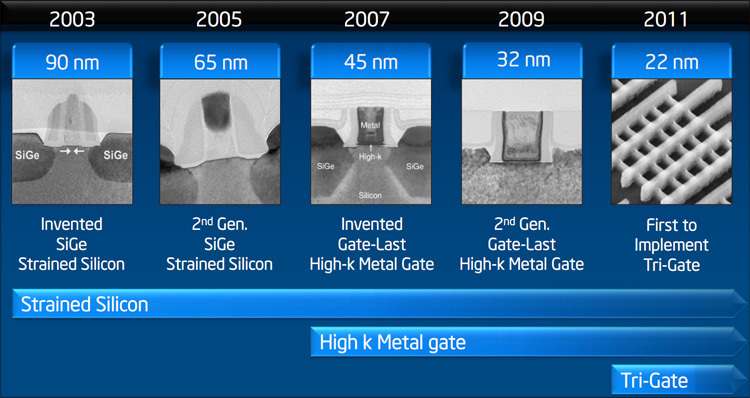Intel wins this year's IEEE Corporate Innovation Award

The Institute of Electrical and Electronics Engineers (IEEE) has announced that Intel will be the next winner of its prestigious Corporate Innovation Award. The award will be given for the development and implementation of mass production of innovative high-k metal gate and tri-gate technologies in Intel processors.
The Corporate Innovation Award was established by IEEE in 1985. It is awarded to companies or organizations "for outstanding innovative achievements" in the field of activity of the IEEE Institute. At different times, Apple Computer became its laureates for the release of the first mass personal computer, Jet Propulsion Laboratory for developments in the field of unmanned space flights, Toyota for the invention of hybrid transmission and SanDisk as the creator of flash memory.
Under the cut you will find a brief history of Intel's award-winning inventions.

Reducing the process of manufacturing processors every year, by 2007 Intel came to the threshold of 45 nm. Further, it was necessary to deal not only with production difficulties but also with obstacles associated with the physical properties of the materials used. The problem was the gate dielectric. As the process decreased, the layer of silicon dioxide used as an insulator reached a thickness of only 5 atoms. Further refinement would lead to leaks through this layer, which, in turn, would cause an increase in losses and an increase in energy consumption. The question arose of how justified the further movement forward. Moore's Law is in jeopardy.
The problem was known in advance, its solution was sought by industry leaders since the mid-nineties. The first was succeeded by Intel, which proposed using material based on hafnium metal as the gate dielectric - its dielectric constant was higher than that of silicon dioxide. The technology was called high-k, where k is the dielectric constant. However, the solution to one problem gave rise to another. The metal dielectric required fundamentally new gate electrodes; old ones made of polycrystalline silicon were no good here. The development of high-k metal gate technology required the incredible efforts of engineers, and the breakthrough story turned out to be so fascinating that its presentation reached the final of the Pulitzer Prize for Journalism.
Tri-Gate or FinFET technology is the result of Intel research to reduce transistor leakage. In the traditional planar structure of a transistor, electric current can flow only along the narrow surface of the conductor under the gate. While in three-dimensional transistors, the current propagates in the thickness of the silicon protrusion, "cutting through" the gate. The result of this design decision is to reduce the resistance of the transistor in the open state, increase the resistance in the closed state and switch more quickly between these states. At the same time, it became possible to reduce the operating voltage and decrease the leakage currents. As a result, a new level of energy efficiency and a substantial increase in productivity in comparison with existing analogues.

The IEEE Award is a recognition of Intel's achievements in solving the most complex microelectronics problems. Of course, you should not think that all the breakthroughs have already been made - in the laboratories of Intel and are currently working on the technology of tomorrow. Topics that will receive their prizes in the future.
